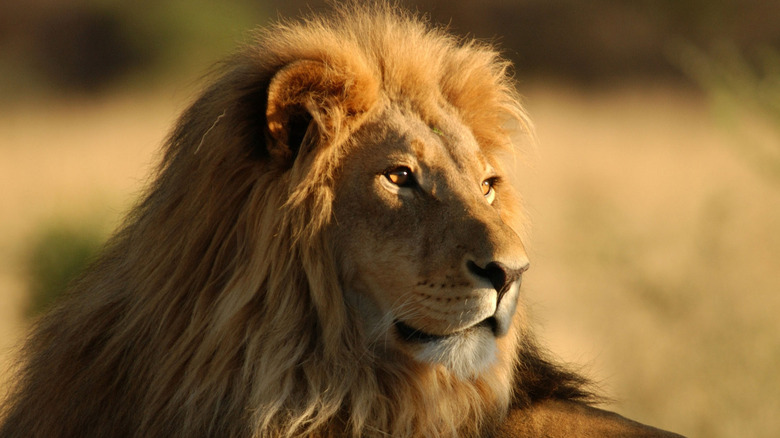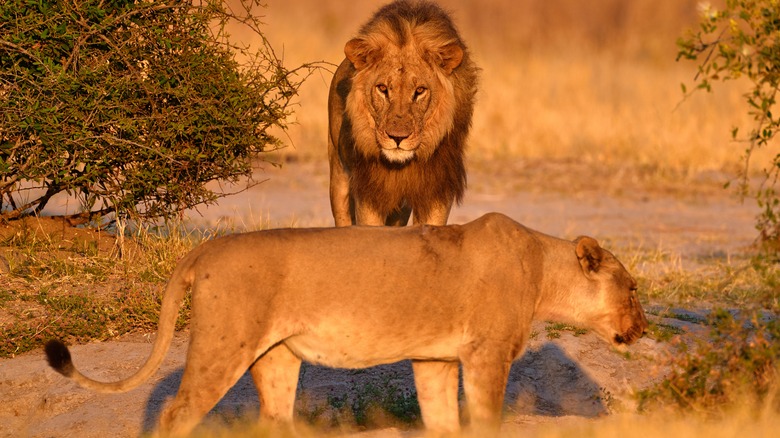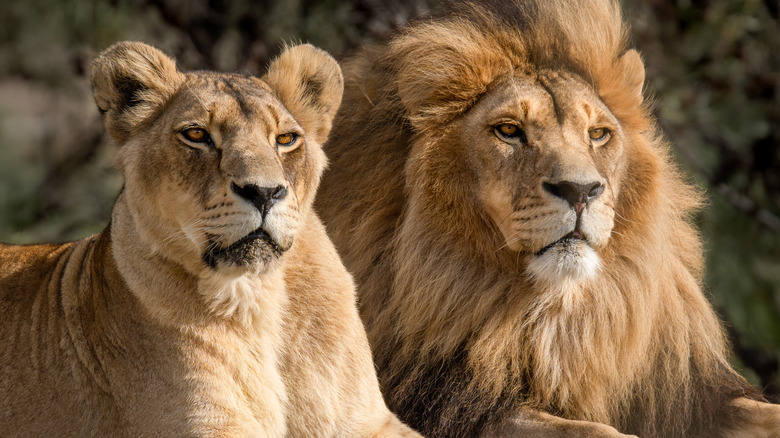You Won't See Many Lions In Europe These Days. Here's Why
Lions are truly majestic, formidable creatures. As National Geographic reports, they're a proud member of the much-ballyhooed "Big Five," considered must-see species on any safari in Africa. Fellow celebrated species on the list are African rhinoceroses, African buffalo, leopards, and African elephants.
Sadly, National Geographic goes on, this list also renders them prime targets for hunters, and their numbers are in decline. In June of 2014, the African lion was added to The IUCN Red List of Threatened Species, and the number of surviving adults was estimated to be between 23,000 and 39,000. "It is of great concern that the vast majority of the population is inferred to have declined at a rate that meets the criteria for Endangered," the report read at the time.
Like many species, lions used to be far greater in number and an awful lot more widespread around the world. Here's why this regal feline is now such a rarity in Europe.
The dominion of lions once spread across the world
According to the United Kingdom's Chester Zoo, the Asiatic lion is an even rarer species. In the wild, they are found almost exclusively in India's Gir Forest, and in 2019, there were only an estimated 650 wild Asiatic lions remaining. The zoo, which opened a huge 4,780 square meter habitat for its own Asiatic lions in October of that year, reported that wild specimens were confined to around 0.1% of the lands the species used to call home.
Chester Zoo goes on to state that "poaching, human-wildlife conflict, habitat loss and disease have caused a catastrophic decline in Asiatic lion populations in their natural range." These reasons, tragically, seem to have largely contributed to the disappearance of lions in Europe too.
As Sapiens Anthropology Magazine reports, the European continent no longer plays host to wild lions. They are star attractions in safari parks and zoos across the continent, but they cannot be found there elsewhere. However, it seems that this noble creature did once live in Europe.
No longer lion around
Sapiens Anthropology Magazine goes on to state that a 1978 archeological dig in Tiryns unearthed an intriguing bone: from the heel of a lion. More were subsequently unearthed, but researchers questioned whether these were simply domesticated lions or relics from elsewhere for decades afterwards. Findings continued to mount, however, and sites across Bulgaria, Hungary and other European nations yielded more lion remains. Some, per Sapiens Anthropology Magazine, dated back to around 4,000 B.C. As Stockholm University's László Bartosiewicz reportedly put it, "I think that it is quite convincing; I really believe that there were lions. So many bones couldn't have been imported."
In the study "Panthera Fossilis (Reichenau, 1906) (Felidae, Carnivora) From Za Hájovnou Cave (Moravia, The Czech Republic): A Fossil Record From 1987-2007," Martin Sabol writes that "the earliest European record of large lion-like felids" is estimated to date back to "(680,000 BP) or even to an earlier period" (BP means "Before the Present").
What happened to European lions? Well, humanity happened. Bartosiewicz suggests, per Sapiens Anthropology Magazine, that "getting in people's way" was the cause of their eradication around the time of the Bronze Age. Humanity's development, just as with modern lions, would surely have caused confrontation with them. Human food and habitats were protected to the detriment of the lions' own, and lions may even have been eaten themselves.
World Atlas reports that lions as a whole are now limited to just 6% of their original worldwide habitats. It seems we really haven't changed very much.


